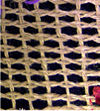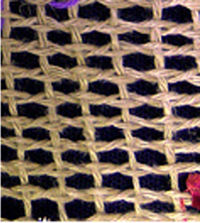SER 2 1: Difference between revisions
No edit summary |
No edit summary |
||
| Line 6: | Line 6: | ||
<tr> | <tr> | ||
<td align="center" valign="middle" height=125 width=100 style='padding:10px'> | <td align="center" valign="middle" height=125 width=100 style='padding:10px'> | ||
<div style="background-color:# | <div style="background-color:#FFFFFF; height:110px; width:90px"> | ||
[ | [[Image:Leno Weave.jpg|100px]] | ||
</div> | </div> | ||
</td> | </td> | ||
Revision as of 02:43, 28 July 2008
| Title: Woven Interconnects | ||
|
About:
|
Tags:
|
|
Woven Interconnects - Open Discussion
Some time back I had a discussion with a textile person on the merits of weaving the interconnects like a cloth rather than using "tape sandwiches". There are some very positive aspects of this and a few drawbacks.
- Pure CNTs can be used in woven interconnects that will not have environmental issues like those expected for adhesives, plastics,...
- Pure CNT interconnects could hand extreme temperatures
- Woven interconnects are not viable for high-speed splicing and difficult to use in repair of the ribbon
- ???
I remember having information (hardcopy) on types of weaves that lock in the cross threads. The simplest is a Leno weave (image). In the Leno weave axial threads are straight and two cross threads will pass on either side of an axial thread then twist once around each other then pass the next axial thread on the same side they started on. This is continued across the set of axial threads and either tied off or brought back on the next pass.
This weave tightens when pulled. It also instills an automatic, consistent spacing. Something like this might do well.
So, to make this work we need to know how slippery the CNTs are and design the number of cross lines around this. The slipperier the CNTs are the more cross threads we need. The good part about this is that it is old technology, experts know what will happen... maybe we should talk with them. It would also be good to see how this deforms under degradation.
A start...

